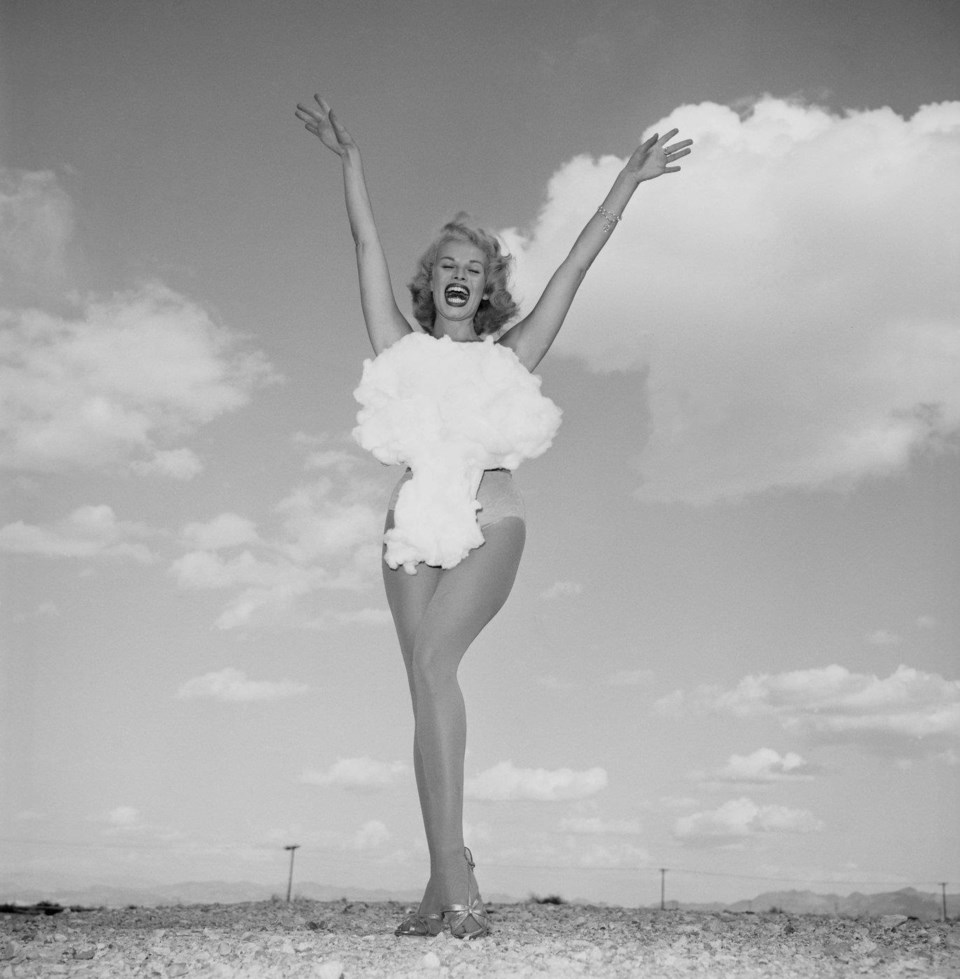LAS VEGAS (AP) ā It wasn't going to be easy to track down the woman who came to be known as āMiss Atomic Bomb." All Robert Friedrichs had to go on was a stage name he found printed under an archival newspaper photo that showed her posing with other Las Vegas showgirls.
It would take him more than two decades to unravel the mystery of Lee A. Merlin's true identity.
Friedrichs, 81, isnāt a detective. Heās a historian and a retired scientist who got his start during the atomic age, a complicated moment in American history when the line was blurred between fear and fascination with nuclear power.
Between 1951 and 1992, hundreds of nuclear tests were performed, mostly , in the desert outside Las Vegas. But it was the massive mushroom clouds from the above-ground nuclear blasts that captured the publicās imagination throughout the 1950s and early 1960s.
Las Vegas sought to capitalize on that craze, and in 1957 sent a photographer out on assignment to shoot a promotional ad for nuclear tourism. He got an idea to capture the lead dancer at the Sands Hotel in a swimsuit in the shape of a fluffy mushroom cloud. In the photo, the high-heeled showgirl is smiling with arms outstretched as the desert unfolds behind her like a stage.
The image played a key role in shaping ā identity as a city of fantasy and spectacle. Yet little was known about the star of the photo ā until now.
Chasing clues
Friedrichs first set out to find Miss Atomic Bomb around 2000. The Atomic Museum was set to open in Las Vegas in a few years and as a founding member, he was āhoping against hopeā that she was still alive and could attend the grand opening.
What started as a simple question ā Who was she? ā became an obsession for Friedrichs that outlasted careers and outlived friends.
Friedrichs filled stacks of binders with clues and potential leads, like one that led him āto a guy in South Dakota." Days off were spent either combing through online newspaper archives or sifting through special collections at the library.
He tracked down the photographer from that famous photoshoot and interviewed former showgirls who confirmed Miss Atomic Bomb's stage name. But the womanās real name still eluded him.
Leads dried up and months turned into years.
The mystery didnāt keep him up at night, but he said when he was awake, it consumed his thoughts. He would sometimes stare at the photo, wondering if sheād ever give up the answer.
Then, last winter, something unexpected happened. He gave a talk at the about his search, and the next day, an audience member sent him a copy of an obituary. A detail stood out: The woman had once been the lead dancer at the Sands Hotel.
Her name was Anna Lee Mahoney.
Beyond the stage name
She was born on Aug. 14, 1927, in the Bronx. Mahoney trained in ballet in New York before performing in shows and musicals under her stage name, Lee A. Merlin.
By 1957, she was the lead dancer at the Sands Hotelās Copa showroom, a frequent haunt of the Rat Pack and mobsters. She performed for elite audiences, including Frank Sinatra and Louis Armstrong, according to her obituary.
After hanging up her dancing shoes, Mahoney worked for 30 years as a mental health counselor, moved to Hawaii and got married. She died in 2001 in Santa Cruz, California, after a battle with cancer.
Her photograph is one of the most requested of the 7.5 million images kept in the Las Vegas Convention Center and Visitors Authorityās archive. It has inspired Halloween costumers, and recreated it in 2012. One of the outtakes from the famous shoot appears in the background of an episode of āCrime Story,ā a police TV drama set in the 1960s.
āItās just really amazing that one click of the shutter could have such an impact,ā Friedrichs said.
A temporary exhibit showcasing the decades-long search opens June 13 at the Atomic Museum.
āItās about Miss Atomic Bomb, about Anna Lee Mahoney,ā said Joseph Kent, the museumās deputy director and curator, ābut itās also about Robertās quest to find out her real identity.ā
New friends and old stories
Over the years, the project had become deeply personal for Friedrichs.
He and the photographer, Don English, became fast friends after their first meeting. Before the Atomic Museum opened to the public, Friedrichs took English inside to tour the space. English brought the original camera he used to take the infamous photo.
English posed in the lobby for a photo with a life-sized cardboard cutout of āMiss Atomic Bomb.ā Friedrichs jokes itās his favorite of all the photos heās collected of her in 25 years.
English died in 2006, long before Friedrichs solved the mystery. Instead he called Englishās daughter to share the news.
āShe was really excited that we had gotten this put to bed,ā Friedrichs said.
And then there were the showgirls who spent hours talking with Friedrichs. They shared their stage names and stories about vintage Vegas ā fancy dinners, photoshoots and lavish gifts like a beautiful citrine ring that one of them got from a man who wanted to marry her.
The women provided a glimpse into the atomic era, life as Copa showgirls and how they became icons of Las Vegas, yet were sometimes misidentified in photo captions or their names altogether omitted.
And finally, with the help of private investigators who donated their time, Friedrichs uncovered conclusive evidence linking all of Miss Atomic Bombās names to a single Social Security number.
āIt's something I always hoped would be completed in my lifetime," said Friedrichs, teary-eyed.
His motivation to solve the mystery didnāt come from curiosity alone. The missing name was a gap in the historical record, he said, and he wanted to fix it.
āItās sort of like knowing someone was the first president of the United States, but what was his name again?ā
Rio Yamat, The Associated Press



